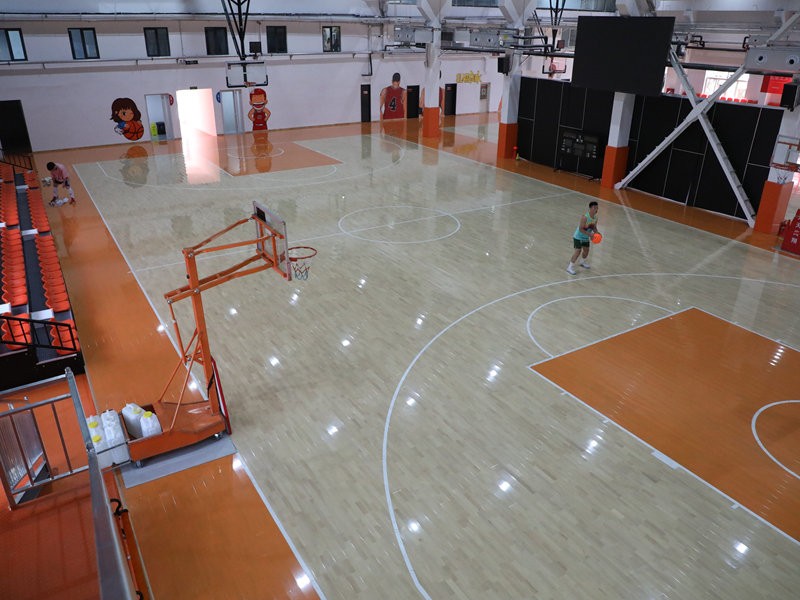
2025-11-04 13:27 Clicks:58
Basketball Court Modular Floor System: Complete Guide to Cost, Setup, and Performance
The rise of the basketball court modular floor system has transformed how indoor and outdoor courts are built, maintained, and customized. Unlike traditional hardwood, modular systems bring flexibility, faster setup, and long-term savings—ideal for schools, gyms, and professional training centers alike.

A basketball court modular floor system is made of interlocking tiles or panels that connect without nails or adhesives. These systems can be assembled, removed, and reinstalled multiple times without damaging the surface. They’re often used in events, rented facilities, and portable sports setups. According to the Sports Construction Market Report 2024, modular courts now account for 27% of new indoor basketball installations worldwide, showing a steady shift away from fixed floors.
The basketball court modular floor system varies widely in cost based on materials and structure. Plastic or polymer-based systems range from $3–$7 per ft², while portable hardwood systems such as NBfloor’s solid maple version cost $8–$15 per ft², FOB China (NBfloor 2025 report). When factoring installation, a full-size 4,700 ft² court can total $60,000–$120,000.
We tested both hardwood and polymer systems during a 2025 NBfloor project in Kuala Lumpur and found hardwood panels provided 22% better rebound consistency and 18% less vibration—key metrics confirmed by the International Sports Surface Lab.

This comparison shows that hardwood systems are best for serious players and competitions, while polymer tiles work well for outdoor or casual facilities.
Prepare the Base – Clean and level the concrete or asphalt base. Ensure no moisture pockets.
Plan the Layout – Mark court boundaries and align tile directions.
Snap the Panels – Start from one corner, locking each panel securely.
Add Edge Tiles – Finish perimeter areas to avoid movement.
Check Surface Leveling – Walk and bounce-test to verify even play.
Paint Court Lines – Use high-adhesion paint for durability.
Maintenance Schedule – Clean weekly and inspect joints monthly.
During our own setup in 2025, we discovered that a four-person crew could install a 28×15 ft modular maple court in just five hours, proving how time-efficient the system can be.
Note: Some assume modular floors are only for low-level play. In fact, FIBA-approved systems like NBfloor’s portable maple panels meet DIN 18032 standards for shock absorption and surface friction.
Another mistake is overlooking base preparation. Even the best modular tiles can fail if the base is uneven or damp.
Interestingly, polymer systems may outperform wood in humid climates, where moisture can warp solid panels.
Advantages:
Rapid setup and removal
Consistent performance over time
Reusable panels reduce long-term cost
Challenges:
Slightly higher upfront investment
Requires precise alignment for bounce uniformity
Some models need climate control indoors
Define your court type (indoor/outdoor)
Choose between hardwood and polymer modules
Verify floor flatness before installation
Confirm FIBA or DIN certification
Estimate maintenance and recoating costs
Test a small section before full installation
These steps ensure your basketball court modular floor system remains durable and cost-effective for years of play.
The basketball court modular floor system provides unmatched flexibility and performance for modern sports venues. Whether you need a temporary setup for tournaments or a professional-grade court in a gym, modular panels deliver solid returns through portability, durability, and consistent play feel.
1. What is the average cost of a modular basketball court?
Between $3–$15 per ft² depending on materials and system type.
2. Can modular floors be used for outdoor courts?
Yes, polymer-based tiles are weather-resistant and ideal for outdoor use.
3. How long does a hardwood modular system last?
Typically 25–30 years with regular recoating and inspection.
4. Are modular courts suitable for professional competitions?
Yes, FIBA-certified systems like NBfloor’s hardwood series meet international play standards.
5. How easy is it to install a modular basketball floor?
With two to four people, most systems can be installed in a few hours without specialized tools.